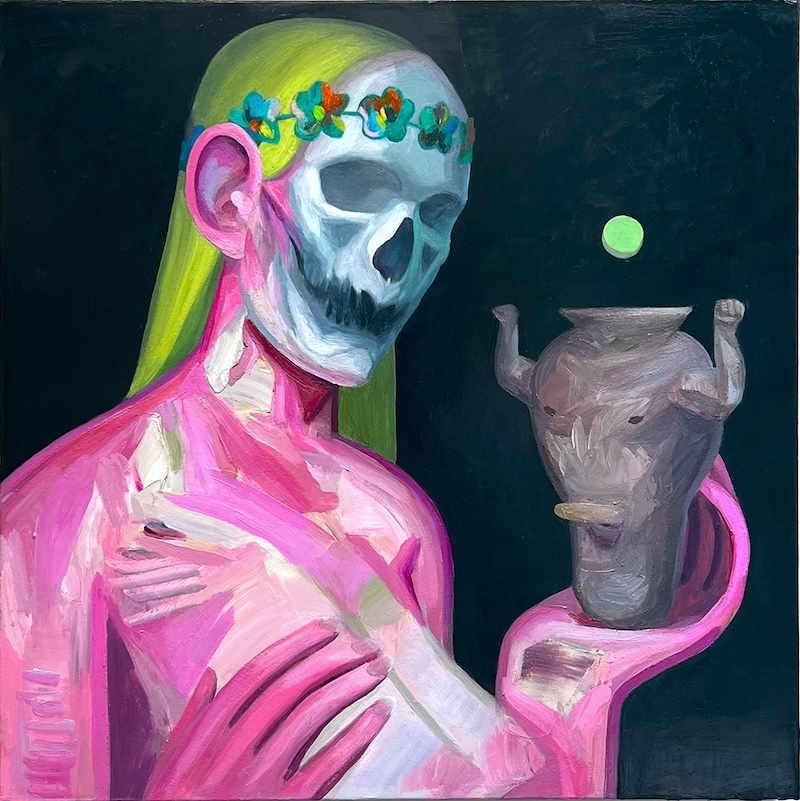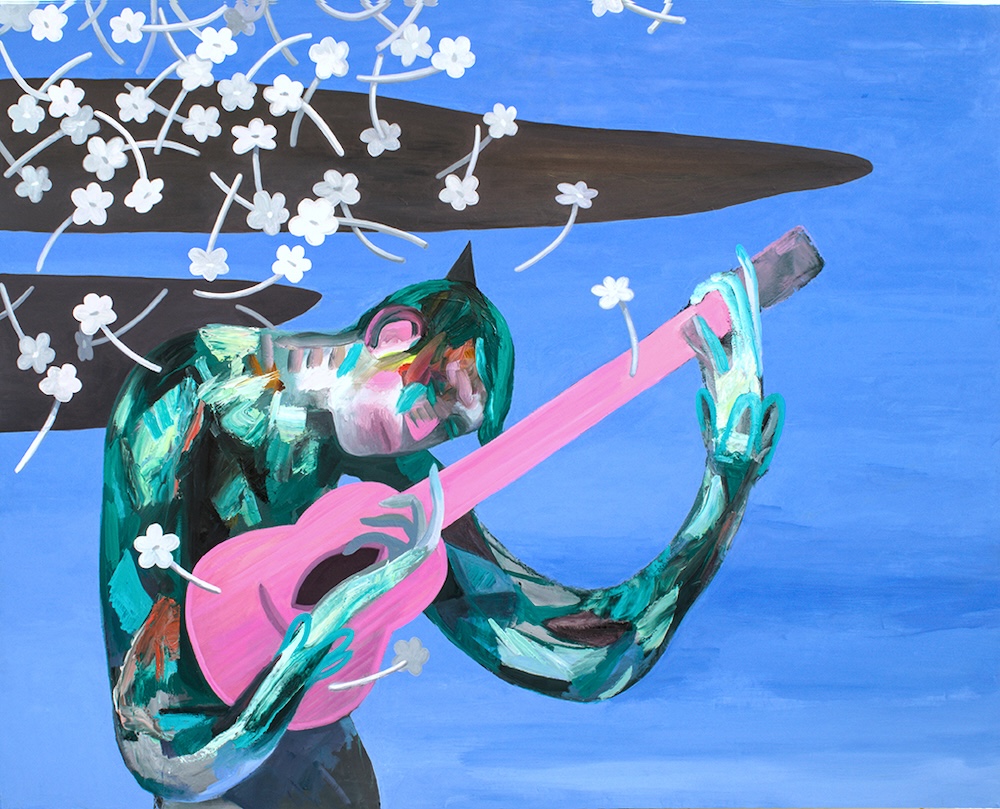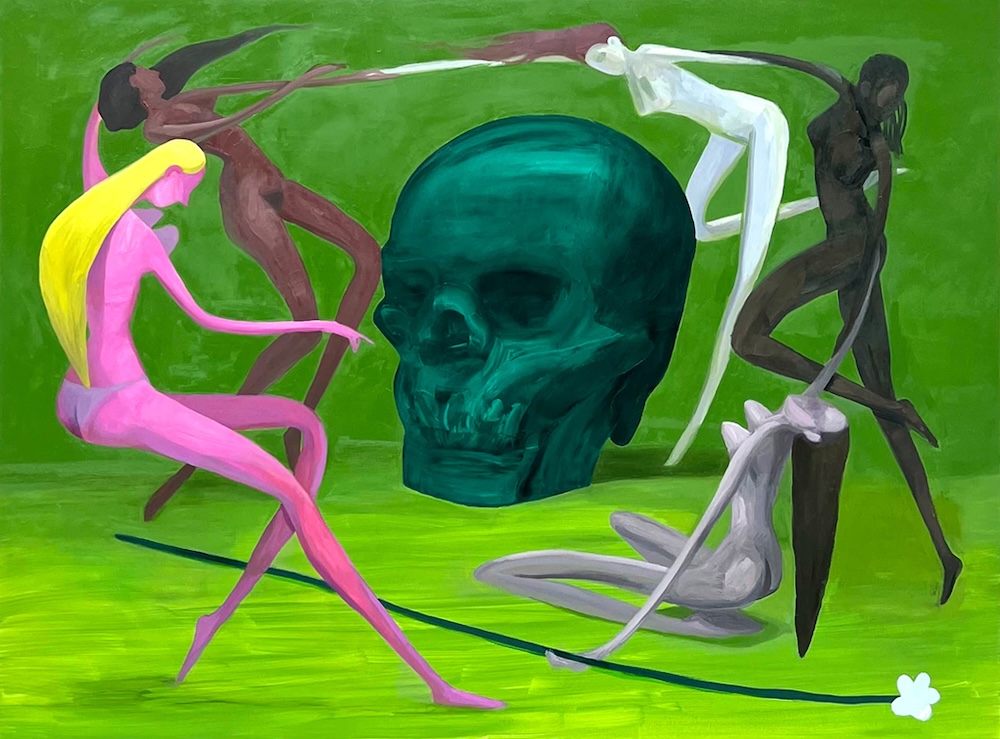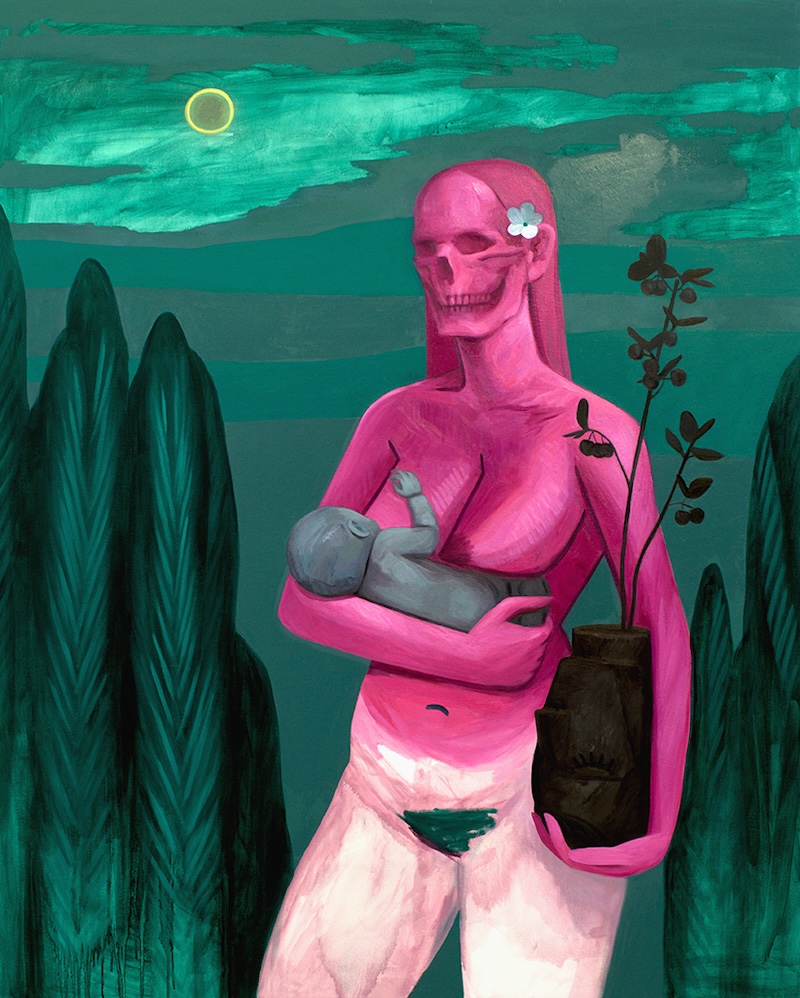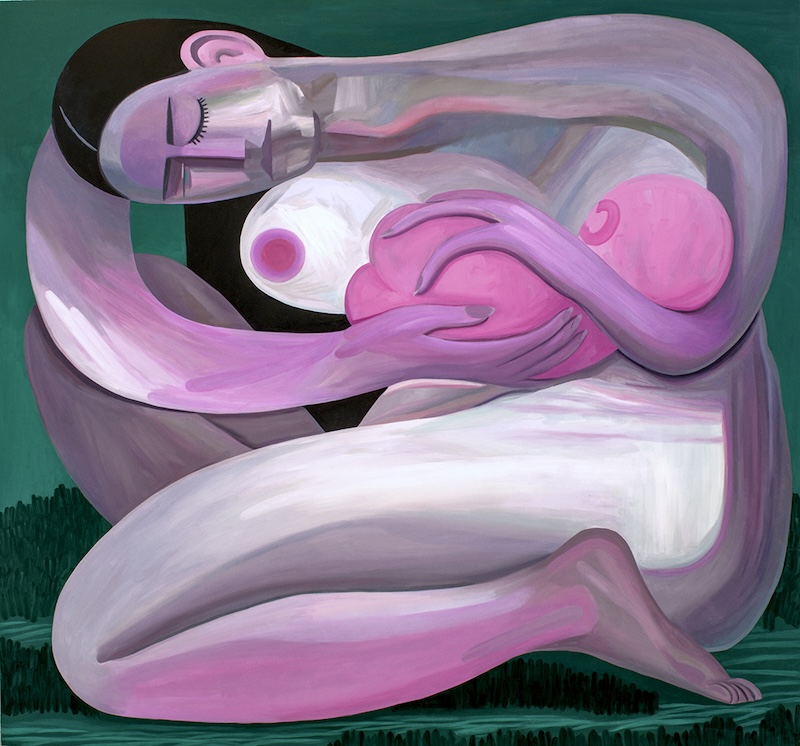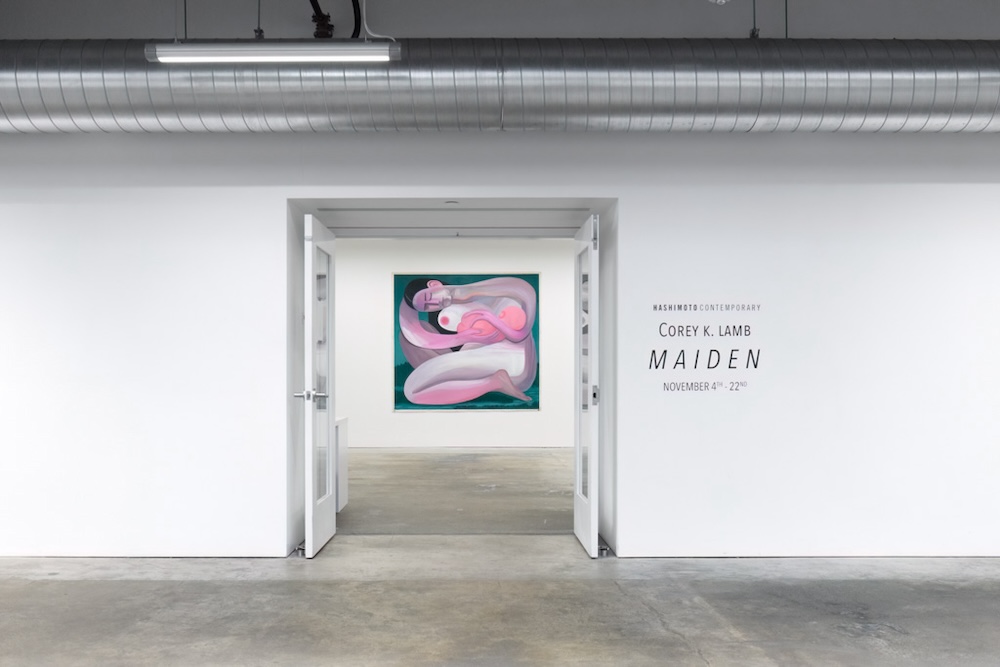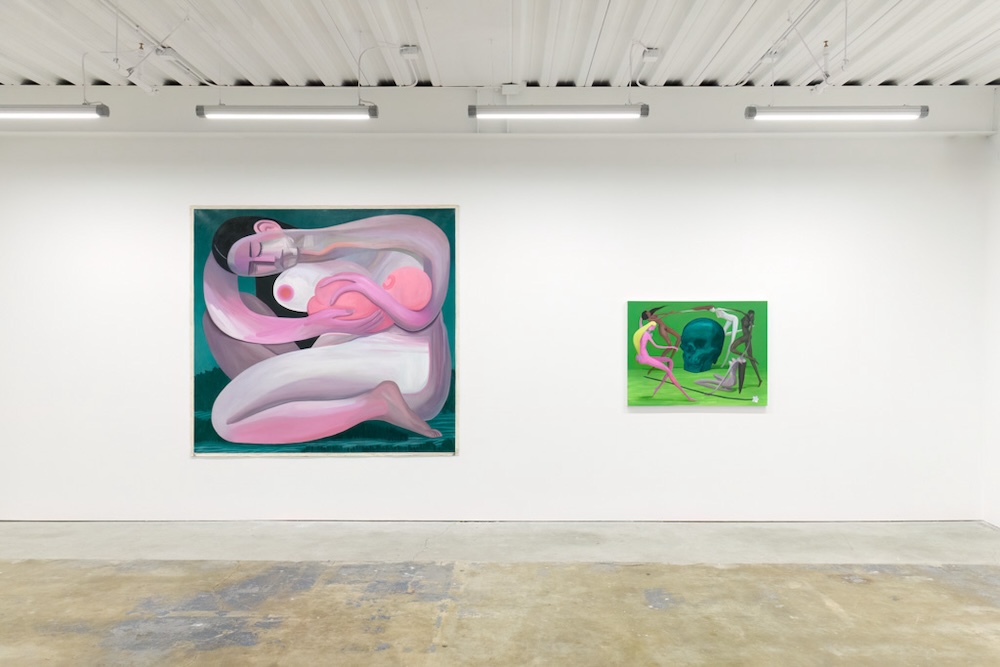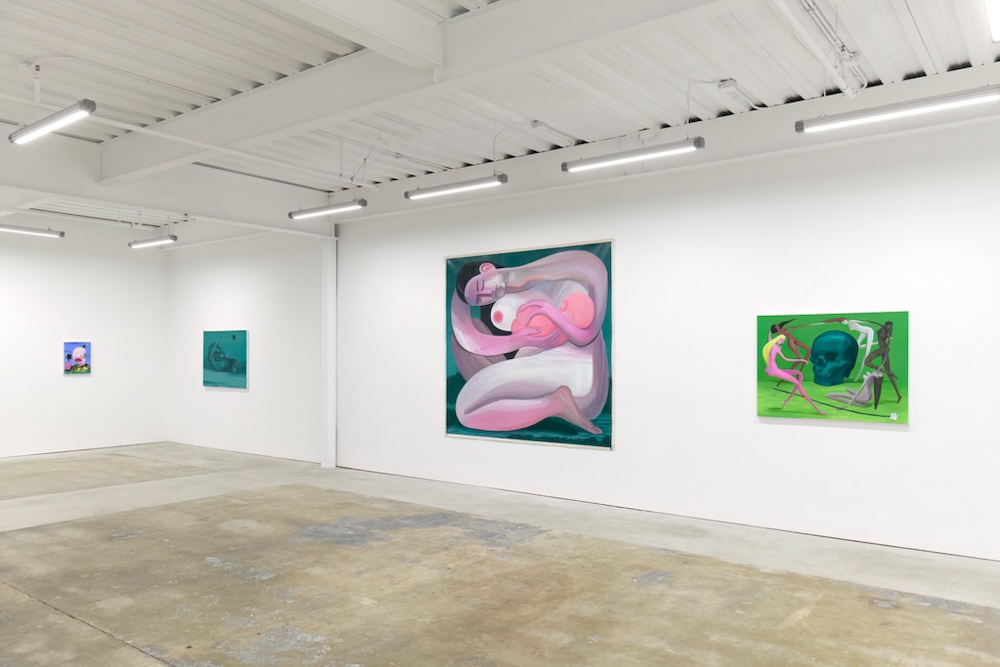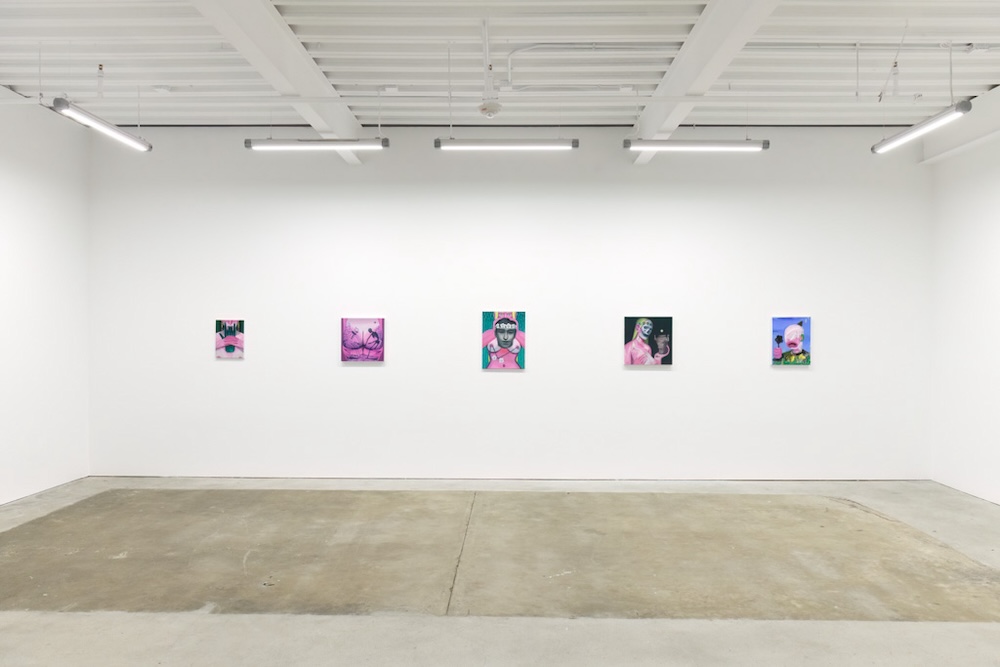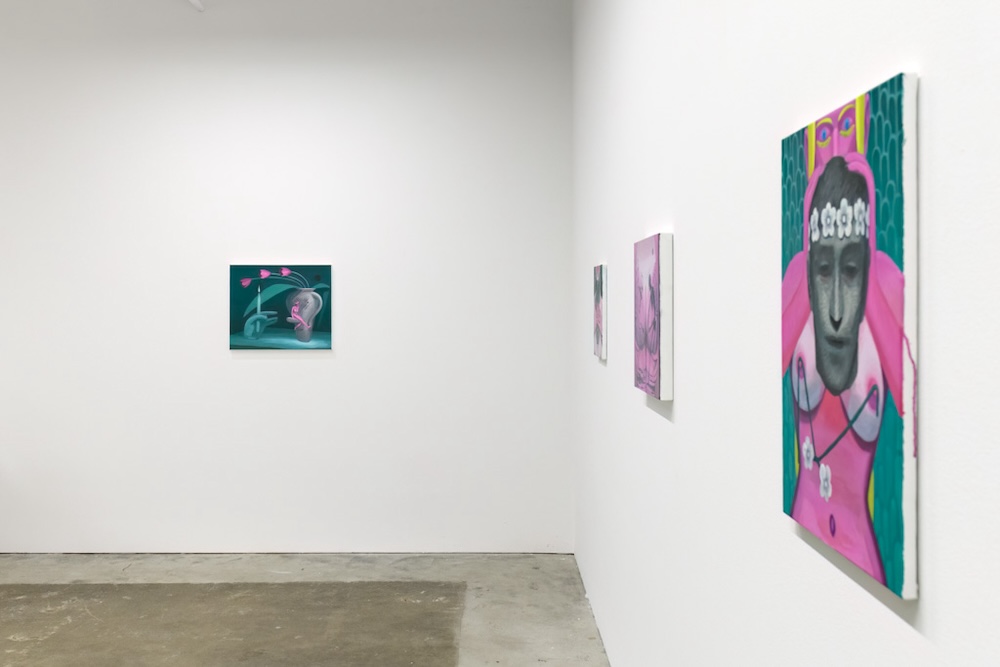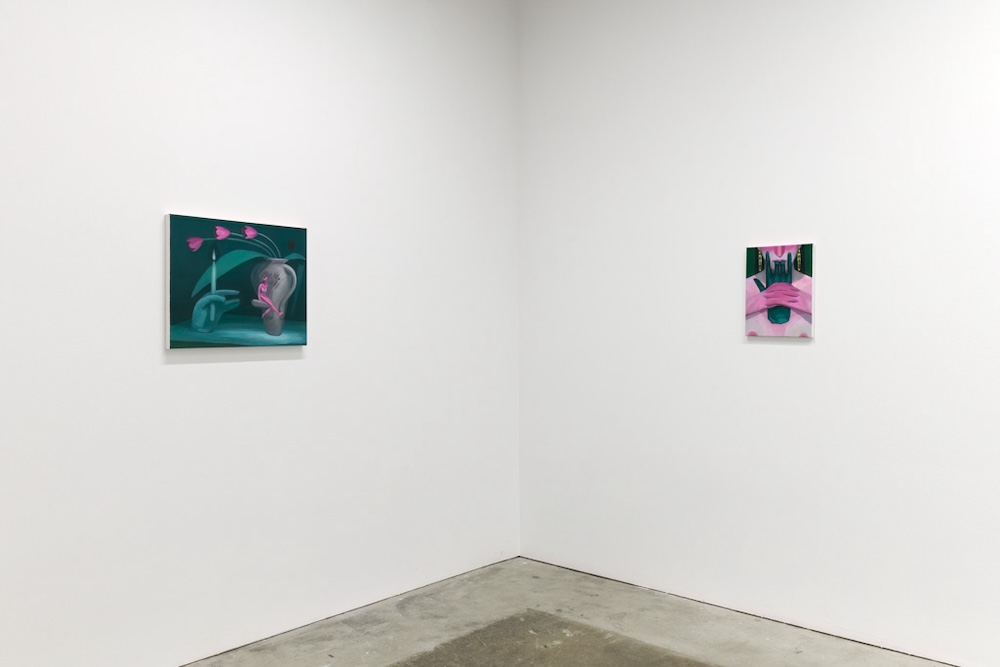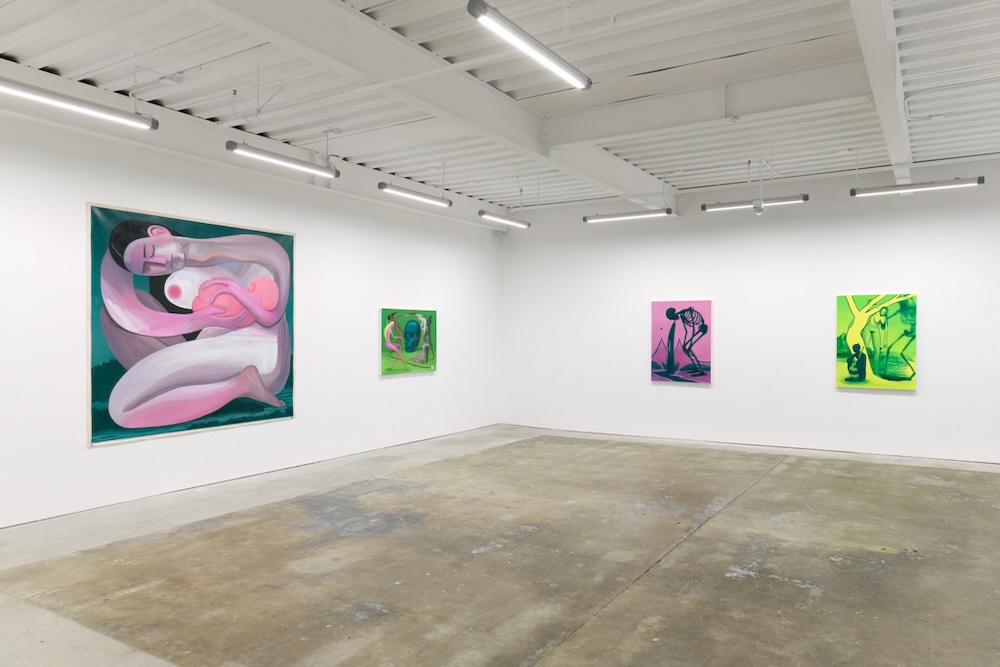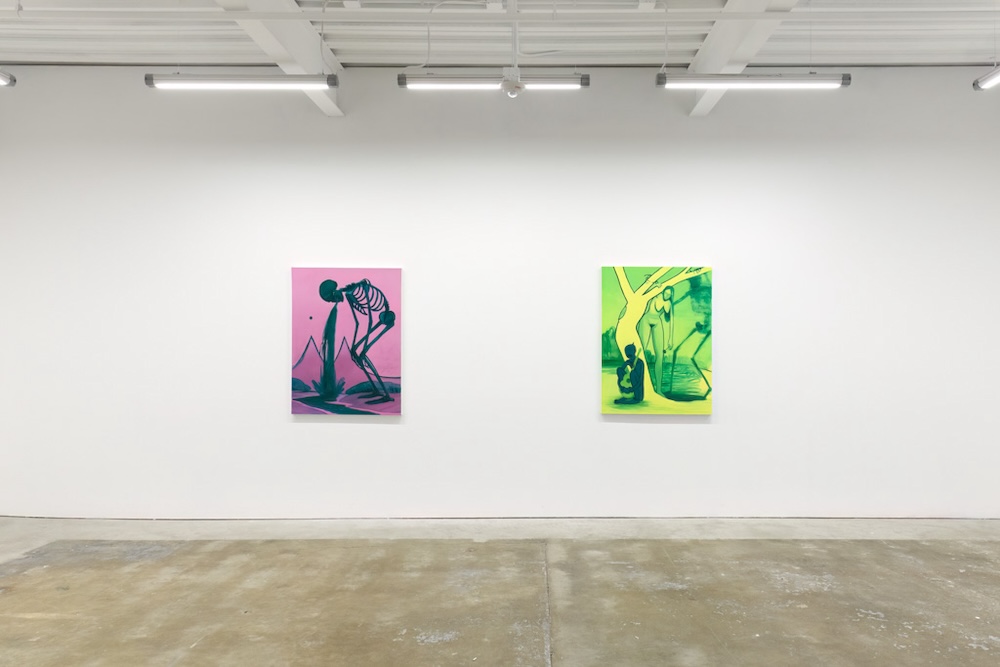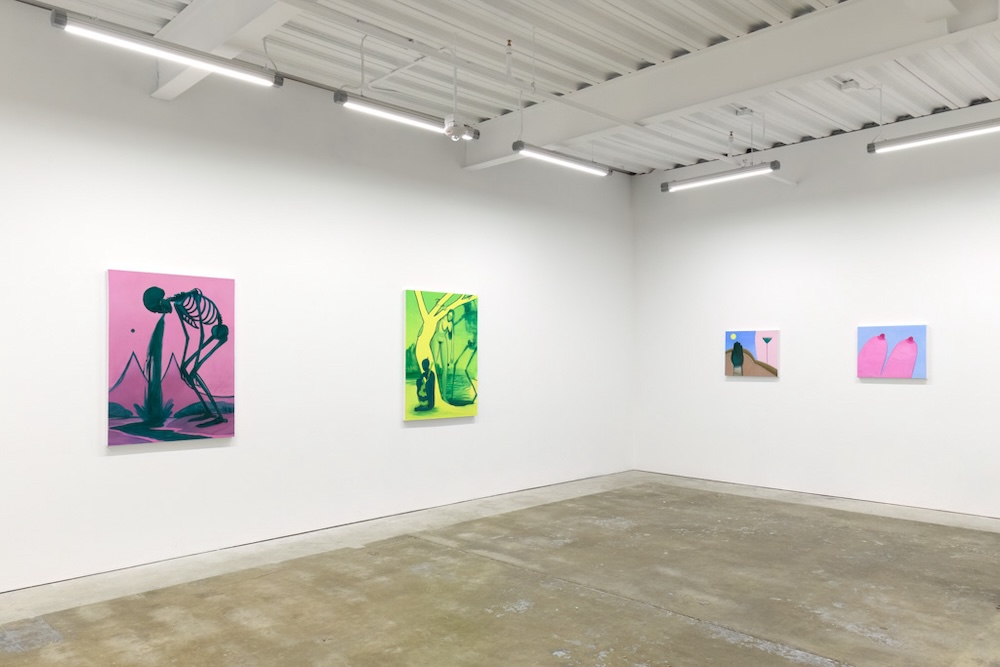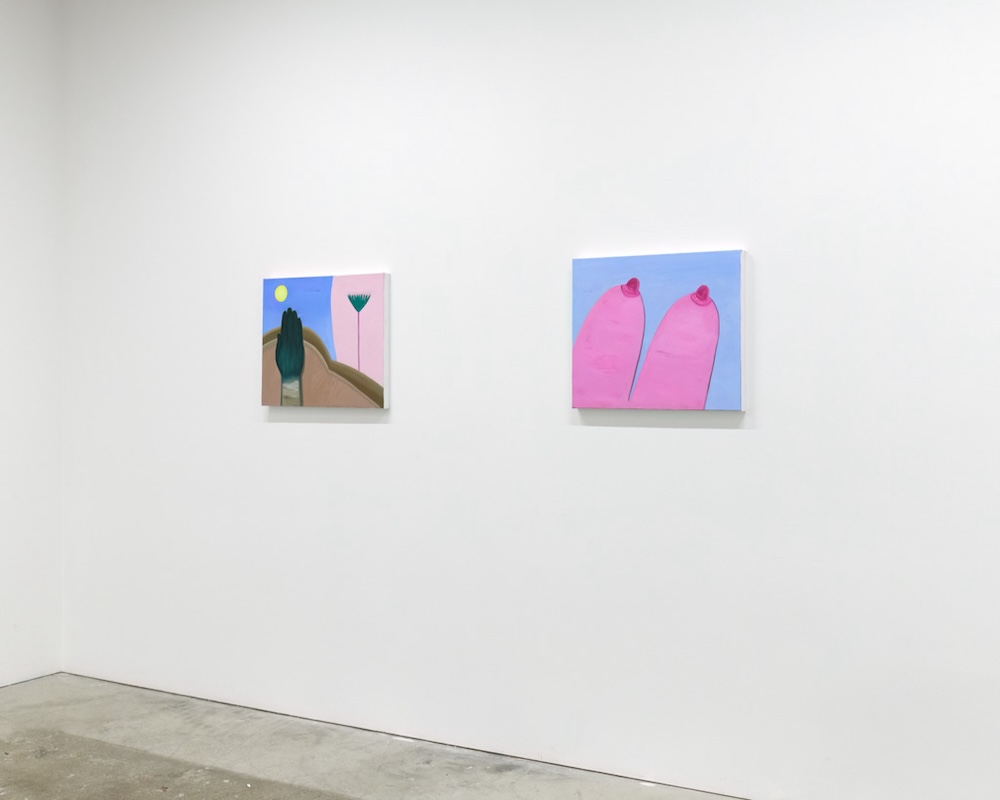The introduction of Web 2.0, along with deregulated internet forums, seemed to create a pressure cooker type microcosm of misogynistic spaces where lamentations about women “gatekeeping” their reproductive power run rampant. These discourses amplify the desire to control women through increasingly violent means, insidious and obvious. But this phenomenon is not native to online discussion boards—the characterization of a woman as either virgin or whore, useful or useless in species productivity, has almost always been peddled by patriarchal institutions.
Painter Corey K. Lamb’s solo exhibition Maiden at Hashimoto Contemporary San Francisco navigates this much longer storyline about the imagined woman archetype (the maiden) and her innate power to choose to reproduce and subsequent external powerlessness. Lamb uses stripped-back, cartoonish figures in bright, fluorescent colors to explore this Western archetype and her sociological and biological double bind: to procreate as the fair maiden or abstain as the old maid. Before his solo show opened, the Florida-based painter spoke to Hashimoto Contemporary’s Katherine Hamilton about his painting practice and its engagement with history, his ongoing exploration of existentialism and eroticism, and the possibility that the archetype of the maiden might vanish altogether.
Katherine Hamilton: You mentioned that your stripped-back style helps contain the narrative inside the frame, so your viewers don’t need an art history degree to decode the work’s meaning. The figures are bare organisms, bodies in situations rather than overtly grand beings, as humans have sometimes been portrayed in the history of painting. What do you find most appealing about painting in this style?
Corey Lamb: Accessibility and relatability are important to me as guiding principles. During my development as a young artist, postmodernism remained dominant in galleries and among academics, and the divide between the artist and the average viewer was intentionally quite wide. Most artists were speaking to a select pool of academic viewers who had just the proper education and background to interpret the work.
My angle is different. Despite relying on the same tools and concepts as those artists, I try to use a base set of recognizable motifs and narrative situations that open as many doors and windows as possible for the viewer. Art history and conceptual development are always present for those who look for it, but I don’t prioritize the viewers who would recognize those features. So, the appeal would be that it’s an open invitation. I don’t want to make artwork for the lowest common denominator, but I do want that person to have the opportunity to engage, even if it’s negative.
I’m still not too interested in illustrating factual information through narrative formats, but I do look for specificity and idiosyncrasy when building out my visual language. This would include random things like color palettes from early CRPGs, MUD-based games of the early internet, early Modernism, Playstation 1 graphics, etc. It’s not executed in an obvious way, but it helps form and build upon specific aesthetics that have influenced me.
You’ve referred to yourself as a history painter at heart. Nerd out—what paintings have you learned from?
This is a short question with a potentially massive answer! Let me try to cut a small piece off this pie.
Concerning “History Painting,” I’ve found the Western canon is mostly accurate in whom we choose to focus on (i.e., Velazquez, David, Delacroix, Gericault, Gentileschi, Caravaggio, etc). Massive resources are needed to pull off grand-scale works, which is peak history painting. These requirements instantly remove anyone without means and ability from the pool. We are left with painters who exemplified and consolidated what was effective and popular in that given location and time. So, I guess which history paintings I’ve learned from would encircle most of the academic Western canon painting: The Death of Sardanapalus, Raft of the Medusa, Oath of the Horatii, Susanna and the Elders, and on and on. They hold up.
The lessons I learned from these pieces that I apply to my own work center around hierarchy and simplification. Despite being crazy complex works of art, most “great” history paintings center around a single narrative action from which every other action or element supports and compliments. There is a natural flow the viewer navigates, no matter how many figures or elements are involved. I try to stay focused on that individual narrative element and let my decisions flow to and from that point, albeit my own compositions are much more singular and stripped down comparatively.
For the past two years, I constantly went back to Goya. History painting is full of poetic movement and idealization of the human figure, even in the middle of a massacre. His work does a fantastic job of shedding that pomp and glorification. The figures are loose and earthly in their representation, and the action is blunt and brutal. Oddly, being that I’m a painter, my favorite work of his is the print series The Disasters of War. They are a large collection of plates that were made unprompted and only published after his death. Their power as small, simple narratives held up against the larger conflict from which they stem is incredible. I’ve really come to appreciate Goya’s unflinching nature and bluntness.
Expectations of sex and sexuality are ongoing themes in your work—your treatment of it is serious and weighty while clumsy and embarrassing. Have you found your language (visual and textual) on this specific theme has changed as you’ve evolved this theme in your practice?
Initially, I approached the subject tongue in cheek (or cheeks in some cases, ha) but with a lot of earnest sincerity. This is still fundamental in the work, but I have given myself more space to be solely sincere, with no irony or cleverness to hide behind or to feint the viewer. This manifests visually in more carefully rendered forms and a smattering of compositions where the sexuality is either vestigial or absent altogether.
I’ve also moved to a more direct way of talking about the work. Previously, I was a bit too preoccupied that I would diminish the paintings by writing about them in too literal of terms. But, I’ve found, in the spirit of “opening doors and windows,” that it’s necessary to provide some form of motivation and context for a strong viewing foundation. This isn’t to say that I believe in some kind of absolute interpretation of what I make, but it does allow fuller participation for people who might otherwise be disengaged.
I want to talk about your relationship to the figures in these pieces. In previous interviews, you’ve mentioned that they’re not nude in innocence: they have tan lines, they usually wear clothes, and they have more agency than the nudes we might be accustomed to viewing in museums. How do you view your relationship as an “author” to these figures? Do you consider yourself their inventor or more as an observer, reporting through painting?
I think “observer” works. These figures exist internally as an amalgamation of all the people I’ve known, seen, drawn, or come into contact with in my life. I just pull them from the mass and onto the surface. Once they’re there, an intuitive dialogue takes place with the painting, which is usually me “doing” and the painting “responding” with either positive or negative feedback. I never quite know what path the painting will take me down, but I try to be patient and persistent as I “observe” the responses.
I’m also wondering about movement: how a painter shows bodies in motion has historically been a way for them to flex their technical abilities. Your figures are in action: contrapposto, holding or grabbing objects or each other, or even dancing around the canvas. Especially in this new body of work, several figures appear limp, lacking bone structure—both male and female bodies are flaccid, almost elastic. Can you say more about these particular choices?
I’m always riding the line between describing the figure as a living, breathing, sentient being with motivations and drive, an organic object bound by instinct and deterioration, and a compilation of paint marks on a surface. The limp elongated figures try to unify all these aspects to convey a sense of melancholic deflation or helplessness that reflects our own reality where we push up against systems, both natural and political, that are colossal and impenetrable. For me, it’s kind of like a dream where you are fighting back an attacker, but all your punches land like soft pillows to no effect. It’s cartoonishly futile, yet your brain keeps telling you to swing.
Your solo show Maiden focuses on women’s side of social-sexual conundrums: the maiden represents both a young woman who can bear children and an older woman beyond childbearing years who has not produced future generations. Was there a particular moment or series of moments that pushed you in this thematic direction?
I came about this in a very roundabout way over the last year. I spent a lot of time in the studio listening to podcasts, news, video essays, and thoroughly soaking in internet forums. Some of the dominant narratives in these spaces have been concerned with hypergamy, involuntary celibacy, social isolation, population collapse, scarcity, and a diminished standard of living. These conversations were mostly held in male-dominated spaces on the internet, which come with a good dose of “dumbassery” and misogyny, but the anxiety and commiseration was palpable and real.
A large portion of the men entrenched in these conversations were bitter about their inability to accomplish what they saw as a natural progression in life: find a spouse, get married, have kids, etc. And they mostly blamed women for “gatekeeping” this from them. This is where I began to focus on social narratives, both historical and contemporary, that seemed to be shaping their perception, and that’s where I found the subject for the show.
My work doesn’t try to present or solve these aforementioned issues. That’s not what I’m interested in, personally. I am mostly concerned with examining a particular role in society that has strong, identifiable features that can be personified and explored in a direct way on a canvas.
On the subject of men, you’ve also spoken about how, throughout the history of painting, there’s a certain posturing to male figures and masculinity, where the male figures are full of “sexual power and muscular aggression.” The male figures in Maiden are anything but—they are clowns, skeletons, sensitive lute-playing youths. Even though the men in this show aren’t aggressive in the typical strong, aggressive manner, they still seem sinister. I think of the work Ingress, which shows a terrified clown and grinning skull opening a woman’s buttocks to enter. Can you say more about your treatment of the male subject?
Masculinity is in a precarious place, which means representing its qualities is ripe for experimentation. In previous work, I tried to focus on presenting male sexuality in a softer, more romantic light, representing a figure interested in reciprocal affection and attraction. The male figures in my current work seem to be born from the longing and yearning I observed in the aforementioned internet forums. These figures feel powerless and defeated, yet their hunger and desire are so great that they’ve become radicalized and dangerous in some instances.
Skulls appear repeatedly in this series of works. As you’ve said, they are as much part of the maiden archetype as the young, supple women in the paintings. Though functionally memento mori, reminding the viewer that they must die, they also might remind us that maidens can give life and take it away. Can you say more about the relationship between the maiden archetype and violence? How do you feel they relate on the canvas and in the world?
Survival is the backdrop for everything we do, whether intentionally or instinctively. Evolution has provided each species with its own set of tools that give any singular specimen a chance of
making it to tomorrow and hopefully reproduce. And that seems to be the major crux—biologically, we are innately prompted to keep this all going through some form of reproduction. We don’t know for what purpose or reason this is critical, but we are hard-wired to execute this function, and our personal lives and narratives are deeply affected by the outcome. This is where the maiden archetype finds its position within the biological and social narratives that we experience. She represents the path forward biologically but is also a person with her own agency, desire, and personal narrative that doesn’t always comply with some evolutionary directive.
Historically, control and violence have been used and enforced against young women in conjunction with chastity and reproduction. We see this in social institutions like religion, education, and law across cultures. This violence is concrete and real. However, many of the men on these forums feel as if some form of invisible violence has been enacted upon them by being either rejected or overlooked. It’s both a personal failure to connect and a biological end to a potential “legacy.” It’s not parallel to the actual violence women have experienced, but it is a tangential experience that lends itself to pain and trauma. So, maybe that’s the link between the character I’ve portrayed and its relationship to violence. I think it’s intrinsic.
The term “maiden” is also also used for guillotines or mythic torture devices. What is it about this archetype that people find so chilling, painful, or threatening?
If I were to venture a guess, I think it isn’t so much fear or negative connotations driving those references but irony. Romantics from the 17th and 18th centuries loved melodrama dripping with poetic tragedy. What is more poetic than getting your head lopped off by a guillotine called “the maiden”?
I think the archetype has tremendous power in the biological sense, but it lacks the social agency to use it. Due to social control and physical threats, the maiden has been suppressed and brought under the thumb of her male counterparts. However, thinking back to the online discourse that prompted the work, the social narrative may change in real-time as women have gained equal rights, sexual freedom, and autonomy within the last century. As a consequence, the archetype might evolve or cease to exist altogether after several generations.
Corey Lamb’s solo show Maiden is on view at Hashimoto San Francisco through November 22nd. Opening night photos by Kuan Ya Wu, installation views by Shaun Roberts.

